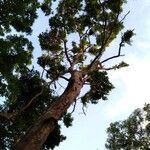Small tree, 5-15(-20) m; trunk and old branches usually crooked, gnarled and furrowed, branched near the base; when young with strong woody simple or branched thorns, up to 10 cm, on trunk and branches, but occasionally (cultivated forms) thornless, specially when old; bark brown to greyish, smooth, not flaky; ultimate branchlets shortly (hispid-)pilose, with numerous warty, rounded or broad-elliptic lenticels. Leaves ovate-oblong or elliptic to oblong-lanceolate, gradually tapered to the long, obtuse tip, rather broadly cuneate to rounded at the base, mostly puberulous at both sides on midrib and nerves, or entirely glabrous, mostly shining above, or dull on both sides, mature ones dark green above, pale green below, young ones shining rose-red or brown, flaccid, drooping, always brown when dry, bitter, rather coarsely toothed, (6½-)10-l 5(-18) by (3-)4-7(-9) cm; midrib and nerves little prominent, but sometimes markedly impressed above, prominent beneath, nerves 5-7(-8-10-12) pairs, curved-ascending, little or distinctly anastomosing, veins ± transverse and distinct, reticulations rather dense and mostly somewhat elevated; petiole 5-8 mm, glabrous or mostly subferrugineous-puberulous. Flowers greenish-yellow, scentless, in few-flowered, short, axillary, finely pubescent racemes. Bracts oblong-ovate, 1 mm. Pedicels 3-4 mm. Sepals (3-)4(-6), ovate-acuminate, 2 mm diam., laxly pubescent on both surfaces. ♂ Flowers: disk-lobes 8, fleshy, orange to yellow-white; stamens numerous; filaments glabrous 3-4 mm; anthers very small, yellow. ♀ Flowers: stamens mostly none, but sometimes present, then mostly reduced in size (staminodes), very rarely normally developed. Ovary flask-shaped, with 4-6(-8) free, suberect styles with a small, indistinctly bilobed stigma. Fruit globose to depressed-globose or a little obovate, 2-2.5 cm diam., 4-7-sulcate or-angular when dry, 5-8 mm peduncled, light-green to pink or purplish-green to dark-red, with whitish pulp, crowned by the 4-6(-8), small, peg-like spaced styles set in a circle.
More
A tree reaching a height of 5-20 m and about 30 cm across the trunk. It can be 40 m tall with a trunk 1 m across. The old branches are usually crooked with furrows along them. The leaves are 5 to 15 cm long and 4-7 cm wide and pointed at the tip. Young leaves are reddish brown and leaves are shiny on top. The young stems are very rough. The flowers are very small and occur in greenish yellow clusters in axils of leaves. They occur with separate sexes in separate flowers. The fruit is a flattened berry with soft juicy flesh and a red colour. The trunk in young trees has many simple spines. The leaf size and shape varies a lot.
Uses. Cultivated for its edible fruits, good for making jams and pies. The fruit is rather variable in shape, size, and colour. The ripe fruit from cultivated specimens is acid and adstringent, but rubbing it between the hands bruises the flesh and causes a chemical change to take place, which renders it sweet and palatable. Wild forms have smaller, very sour and bitterly tasting fruits. Propagated by root-suckers which are abundantly produced.In the Philippines the roots are medicinal, and their decoction is given internally to women after childbirth. The adstringent juice of the young fruit is given for diarrhoea and dysentery, also for dysmenorrhoea. The juice of the leaves is applied to inflamed eye-lids.The wood is very hard, occasionally (Philippines) made into pestles or shafts.
More
The fruit are eaten raw when ripe. The fruit are rolled between the hands to reduce the astringency. It can be sour and is used for jam, sauce or pickles. The young leaves and shoots are edible. The young roots are edible.

